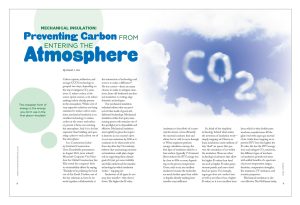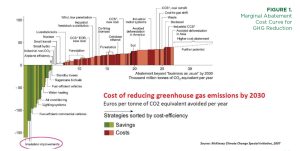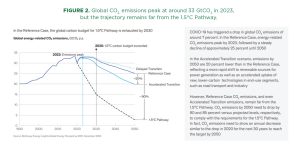Mechanical Insulation: Preventing Carbon from Entering the Atmosphere
Carbon capture, utilization, and storage (CCUS) technology is grouped two ways, depending on the way it mitigates CO2 emissions: 1) reduce carbon at the source (point source), or 2) reduce existing carbon already present in the atmosphere. While a lot of very expensive solutions are being examined to reduce carbon emissions, mechanical insulation is an excellent technology to reduce carbon at the source and reduce or prevent it from ever entering the atmosphere. And it is a lot less expensive than building and operating a plant to suck carbon out of the atmosphere.
At a Construction Industry Institute/Construction Users Roundtable presentation in August 2021, (now retired) Microsoft Corporate Vice President for Global Construction Jim Ellis stated his company’s drive to sustainability efforts by saying, “Frankly, we’re polluting the heck out of this Earth. I believe one of the key solutions is, how do we work together, collaboratively at the intersection of technology and science to make a difference?” He was correct—there are many choices to make to mitigate emissions, from old-fashioned mechanical insulation to cutting-edge futuristic technologies.
Our mechanical insulation industry believes that our products fit that mold of good, old-fashioned technology. Mechanical insulation is like that quiet, unassuming person who remains out of the spotlight, yet is dependable and effective. Mechanical insulation must rightly be given the respect it deserves in our country’s drive to net-zero emissions by 2050 as it continues to do what needs to be done day after day! Our industry believes that unassuming mechanical insulation could play a larger role in supporting these climate goals if it just got more visibility and folks understood the timeless technology by which insulation works— trapping air!
Insulations of all types do not stop heat transfer—they slow it down. The higher the R-value (resistance to heat flow) of a material, the slower or less efficiently the material conducts heat and allows hot or cold to move through it. When engineers perform energy calculation surveys, the first layer of insulation added to a bare surface (typically 1” if mineral fiber) reduces the BTU energy loss by close to 80% or more, depending on the process temperature. Gases, such as air, are excellent insulators because the molecules are much farther apart than solids or liquids, thereby making heat transfer very inefficient.
So, think of the simplistic technology behind what makes the invention of insulation work—simply trapping air. Fibrous or foam insulations create millions of tiny “dead” air spaces that prevent the circulation of air within the insulation. There are other technological advances that allow for higher R-values than dead air, such as higher R-value gases, vacuum panels, and nano-sized dead air spaces. For example, argon gas does not conduct heat as well as air (thus it has a higher R-value), so it is an excellent insulator, which is why double-pane windows manufacturers fill the glass void with argon gas instead of air. Aside from trapping air to prevent BTU loss (the higher the R-value, the less the BTU energy loss) and mitigate CO2 emissions, the different types of mechanical insulation provide end users with added benefits of a spectrum of process temperature ranges, densities, compression strengths, fire resistance, UV resistance, and acoustic properties.
Mechanical insulation is also cost effective. The McKinsey study, (Figure 1) shows insulation is the MOST cost-effective solution after researching a myriad of technologies that can be employed to reduce greenhouse gas (GHG) emissions.
As I often say on behalf of our industry, “The cheapest form of energy is the energy you don’t use in the first place—insulate!”
Mechanical insulation is a great example of a simple, low-cost, yet highly effective, point-source carbon reduction strategy—especially since many applications are at higher temperatures—that minimizes the CO2 being emitted in the first place. NIA member company Shannon Global Energy Solutions (Shannon) out of New York documented savings on a 350° steam system with just 48 fittings. By adding only 1.5” of removable/reusable insulation covers to areas such as valves, steam drums, flanges, and strainers, Shannon showed a 10-month payback on a $31,000 installed job. Better yet, the CO2 savings were 444 tons by adding the insulation to these 48 areas. Doing a simple calculation, the result is a cost of $70 per ton of CO2 removed. A key measure to show productivity of a project is dollars spent to remove a ton of CO2. Just think—something as simple as trapped air can result in these tremendous benefits for the end user.
There are other technologies that are much more sophisticated than unassuming mechanical insulation and have been developed to reduce CO2 at the source, or even more complex technologies that suck CO2 out of the air. Our federal government, primarily the Department of Energy (DOE), and private companies have been busy investing millions of dollars in new technologies:
- From an October 2021 DOE statement, “The U.S. Department of Energy (DOE) today announced $45 million in funding for 12 projects to advance point-source carbon capture and storage technologies that can capture at least 95% of carbon dioxide (CO2) emissions generated from natural gas power and industrial facilities that produce commodities like cement and steel. These research and development, front-end engineering design and engineering-scale projects are a part of DOE’s efforts to deploy a portfolio of innovative solutions to help achieve the Biden-Harris Administration’s goals of net-zero carbon emissions by 2050 and a 100% clean electricity sector by 2035. ‘In order to dramatically reduce carbon pollution in our fight against climate change, we must deploy all of the tools at our disposal, including the innovative technologies that capture CO2 emissions before they reach the atmosphere,’ said Secretary of Energy Jennifer M. Granholm.1
- As reported by CNN in May 2022, the DOE announced a massive investment in direct air carbon removal projects. This technology removes carbon dioxide out of the air and either permanently stores it or it has to be transferred away. The infrastructure law passed in November included $3.5 billion for four regional direct-air capture (DAC) hubs ($875,000,000 each) across the United States, which aim to remove at least 1.1 million tons of CO2 each per year. This comes to $795 per ton removed. The DOE will work with companies to develop and refine the technologies by which they will remove the CO2 and scale it quickly to make it cost effective.2
- Bloomberg reported that the world’s largest operational system for carbon capture and storage, the Orca plant in Iceland, has been up and running since September 2021. Using a system of fans, filters, and heaters, and powered by a nearby geothermal power plant, it has the capacity to pull 4,400 tons of carbon dioxide out of the air each year and pump it into underground caverns where the gas, mixed with water, will slowly become stone as it cools. The cost of this plant was $10 to $15 million.3 This comes to $3,250 per ton.
- As reported in Chemistry World in June 2022, the United Kingdom’s largest carbon-capture project, Tata Chemicals Europe plant at Northwich, will eventually capture 40,000 tons of carbon dioxide a year for use in making sodium bicarbonate. The unit will capture more than 10% of the carbon dioxide produced at the site’s combined heat and power plant (CHP). The plant is stated to cost 20 million British pounds (approx. $23 million U.S. dollars).4 This comes to $575 per ton removed.
The 2015 Paris Agreement commits the 191 countries that have joined the agreement to limit the global average temperature rise to well below 2°C above pre-industrial levels, and to aim for 1.5°C by 2050. There is promise in these technologies to help countries and companies help meet their sustainability goals. Figure 2 shows, however, that the world is far from this goal.
Conclusion
Companies and governments are evaluating all kinds of technologies to mitigate CO2 emissions in order to attain their goals or the ones of the Paris Agreement. Insulation is a part of that solution, and the technology is to simply invest in its trapped air. Mechanical insulation has been an economical and successful technology for decades, and increasing its use for decarbonization will also give companies a number of other benefits like personnel protection and process efficiency. It also saves on energy bills the minute it is installed. And it keeps on saving every day thereafter. Old-fashioned mechanical insulation is not low-hanging fruit, but fruit that is ripe for the picking!
References:
1. https://www.energy.gov/articles/doe-invests-45-million-decarbonize-natural-gas-power-and-industrial-sectors-using-carbon
2. https://www.cnn.com/2022/05/19/politics/doe-carbon-capture-investment-climate/index.html
3. https://www.bloomberg.com/news/features/2021-09-08/inside-the-world-s-largest-direct-carbon-capture-plant
4. https://www.chemistryworld.com/news/uks-first-industrial-scale-carbon-capture-plant-opens-in-cheshire/4015867.article



